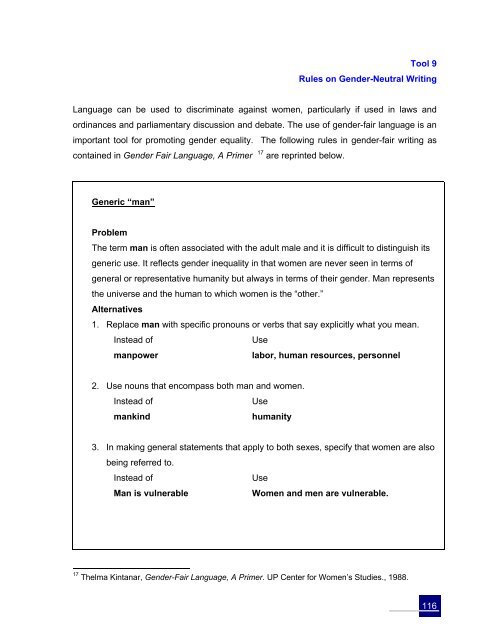Local Legislators' Toolkit - The Sangguniang Panlalawigan ng ...
Local Legislators' Toolkit - The Sangguniang Panlalawigan ng ... Local Legislators' Toolkit - The Sangguniang Panlalawigan ng ...
Tool 9Rules on Gender-Neutral WritingLanguage can be used to discriminate against women, particularly if used in laws andordinances and parliamentary discussion and debate.
- Page 77 and 78: Tool 2Guide Questions for Organizin
- Page 79 and 80: CommitteeFunctionsEnvironment andNa
- Page 81 and 82: E. SETTING UP THE OFFICE OF THE SEC
- Page 83 and 84: Tool 2Sample Organizational Chart o
- Page 85 and 86: F. SETTING UP THE LEGISLATIVE-EXECU
- Page 87 and 88: Tool 1LLEDAC Areas of Concern<stron
- Page 89 and 90: Tool 3Sample Ordinance Creating the
- Page 91 and 92: ENACTED UNANIMOUSLY: 25 November 20
- Page 93 and 94: Section 5.Mayor as Co-Chairperson;
- Page 95 and 96: RULE VI ORDER OF BUSINESSSection 18
- Page 97 and 98: which may be funded from local reve
- Page 99 and 100: A. FORMULATING THE LEGISLATIVE AGEN
- Page 101 and 102: the LA team conducts its own planni
- Page 103 and 104: Step 2. Identifying and prioritizin
- Page 105 and 106: Step 5. Formulating goals and objec
- Page 107 and 108: Tool 3Sample Format of Priority Leg
- Page 109 and 110: Step 9: Mobilizing support of stake
- Page 111 and 112: WHEREAS, the Legislative Agenda of
- Page 113 and 114: Step 12. Managing the LAThe
- Page 115 and 116: The following tool
- Page 117 and 118: Tool 1Steps in Fishbone Analysis<st
- Page 119 and 120: Tool 3Basic Research Methods<strong
- Page 121 and 122: 5. Transitional Provisions• Trans
- Page 123 and 124: Tool 6Checklist: Requisites of a Va
- Page 125 and 126: 5. Mood• Always try to express id
- Page 127: Tool 8A Final Checklist for Draftin
- Page 131 and 132: C. ENACTING ORDINANCES AND CODES OF
- Page 133 and 134: Step 6. The commit
- Page 135 and 136: Tool 2The
- Page 137 and 138: 6. First Reading and Referral of Me
- Page 139 and 140: 3. Conducting a Committee Meeting a
- Page 141 and 142: Tool 5Template: Minutes of a Public
- Page 143 and 144: 4. Codification of Ordinances<stron
- Page 145 and 146: Step 3. Organization and DraftingOn
- Page 147 and 148: Tool 8Template: Resolution Creating
- Page 149 and 150: Tool 9Template: Action Plan for Cod
- Page 151 and 152: Tool 12Sample Code of General Ordin
- Page 153 and 154: ecreation, relaxation, avocation, p
- Page 155 and 156: Article.Section 2A.03. Exemptions.
- Page 157 and 158: CHAPTER IIIHEALTH AND SANITATIONArt
- Page 159 and 160: 6. Vaccinator’s signature7. Veter
- Page 161 and 162: CHAPTER IVTRANSPORTATIONArticle A.
- Page 163 and 164: Section 4A.07. Time of Payment. <st
- Page 165 and 166: Section 4A.22. Validity of MTOP and
- Page 167 and 168: measured from the road surface and
- Page 169 and 170: in Court against him/her. (Ord. No.
- Page 171 and 172: Section 5B.02. Rules and Regulation
- Page 173 and 174: licensed cockpit.c) Gaffer - refers
- Page 175 and 176: Section 6A.02. Rules and Regulation
- Page 177 and 178: Section 6D.02. Rules and Regulation
Tool 9Rules on Gender-Neutral Writi<strong>ng</strong>La<strong>ng</strong>uage can be used to discriminate against women, particularly if used in laws andordinances and parliamentary discussion and debate. <stro<strong>ng</strong>>The</stro<strong>ng</strong>> use of gender-fair la<strong>ng</strong>uage is animportant tool for promoti<strong>ng</strong> gender equality. <stro<strong>ng</strong>>The</stro<strong>ng</strong>> followi<strong>ng</strong> rules in gender-fair writi<strong>ng</strong> ascontained in Gender Fair La<strong>ng</strong>uage, A Primer 17 are reprinted below.Generic “man”Problem<stro<strong>ng</strong>>The</stro<strong>ng</strong>> term man is often associated with the adult male and it is difficult to disti<strong>ng</strong>uish itsgeneric use. It reflects gender inequality in that women are never seen in terms ofgeneral or representative humanity but always in terms of their gender. Man representsthe universe and the human to which women is the “other.”Alternatives1. Replace man with specific pronouns or verbs that say explicitly what you mean.Instead ofUsemanpowerlabor, human resources, personnel2. Use nouns that encompass both man and women.Instead ofUsemankindhumanity3. In maki<strong>ng</strong> general statements that apply to both sexes, specify that women are alsobei<strong>ng</strong> referred to.Instead ofUseMan is vulnerableWomen and men are vulnerable.17 <stro<strong>ng</strong>>The</stro<strong>ng</strong>>lma Kintanar, Gender-Fair La<strong>ng</strong>uage, A Primer. UP Center for Women’s Studies., 1988.116



